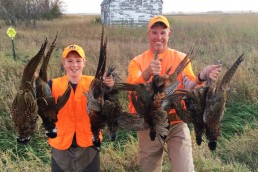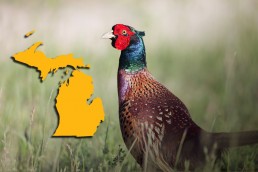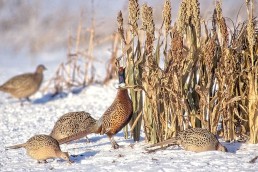Four Factors for More Pheasants
SHARE THIS POST
Like my fishing strategies, I try to keep my hunting strategies simple: Good land (food, water, cover), a good dog (well trained and obedient) and a good strategy (plan of attack) will put pheasant pot pie on the table. Many hunters are missing at least one or two of these three key ingredients. Think of these three factors being worth 33% of a good hunt.
For now, I’m going to key on the strategy portion of the equation. So, you pull up to a good-looking spot (food, water, cover); in fact, the birds are flying around, running into the cover across the road in front of the truck, cackling—all that good stuff. Should be easy, right? Could be…or not at all. There are a couple of things that can make or break the success of the hunt.
1. Noise control
Pretend you’re deer hunting. Leave the noise at home. Park in a good spot—nowhere near where the birds were spotted or “should be.” I typically park way downwind in a low spot. You’re going to work the dogs into the wind anyway, plus the wind carries any noise away from the hunting area.
I know this is basic, but don’t forget to not slam the car doors when you get out. It’s like an alarm clock to wild birds. Pen-raised birds could care less.
As hard as it is, try not to carry on a long, loud conversation about the plan of attack; get that done in the truck before you get out.
No whistles or beeping dog collars, either. Train your dog to read hand signals or listen to soft noises/clicks, etc. A well-trained dog that hunts close (10 to 20 yards) and isn’t a bird chaser shouldn’t need anything loud to control it. (Running after your dog chasing a running bird with a loaded gun is noisy, unsafe and frankly rude to other hunters.). I’m almost to the point that I will not hunt with owners that yell the name of their dog every 60 seconds or actually use a whistle to “steer or control” the dog. Again, noise control—no yelling, whistles, or beeps coming from a dog collar every 30 seconds.
2. Speed
Part of the fun pheasant hunt is watching the dog(s) methodically locate, pin and flush the birds. A nice, slow pace, with frequent stops—like a relaxing stroll through the park—will out-perform any fast-paced hunt. Walking at a fast speed in s straight line and telling the dog where to go is a sure way to go home skunked. The dog has the nose, let it guide the hunt.
Again, a well-trained dog will take its time and hunt close. A poorly trained dog will work faster than you can walk, get way out ahead of the group, chase birds and push the birds too fast, causing worthless out-of-range flushes. Slow and methodical hunting will keep any pheasant tucked in much longer and help keeping the bird from running or flushing prematurely. So, in other words—slow down.
Are you enjoying this post?
You can be among the first to get the latest info on where to go, what to use and how to use it!
3. Work the edge
The edge factor is just as important in pheasant hunting as it is when fishing or deer hunting. Sure, there are birds in the middle of huge tracts of CRP or endless corn fields—but save that for later and work the edges first. Crop edges are key. It seems that most active birds are within 100 yards or less of the crop edge. When at all possible, work the edges of where different food sources or cover collide or “mesh” together, into the wind or crosswind, to give the dogs an advantage. Experienced dogs can hunt any wind, but it always better to hunt into the wind or cross wind.
A classic edge is where soybean or cornfields connect to grassy/CRP type of cover. The edges of sloughs or ponds are also obvious targets. Fence corners where four different fields/crop/cover types meet can also be good.
Visual edges close to the road or parking areas will always be hunted heavily. Look for edges that are a long walk from any road or over difficult terrain will often hold birds that have not been hunted as much. And if you spot an edge that is “marginal” or doesn’t look all that good—hunt it! It probably has been overlooked by most hunters for the same reason!
4. Trust the dog
Follow the dog. This sounds simple, but it is amazing to me how many hunters try to tell their dog where to go or where the birds are. Trust me, the dog knows much more about where the birds are hiding. The minute my small Munsterlander gets out of the truck, she is nose-in-the-air, finding scent. If there are a bunch of birds in a plot, she will tell me instantly. If she gets out of the truck and there are no birds in the plot, she knows it—and we leave (I’ve tested this theory a hundred times, and she is always right).
On that note, if she tells me there are a bunch of birds in the plot and I have a mental plan to start on a certain edge, I scrap my plan and follow her aimlessly into the plot/cover. She will lead us to the heaviest scent or conglomeration of birds. And, I will tell you, half the time I’m questioning why we are walking in the direction we are going (lol). But again, she is always right! Let the dog steer you; you don’t steer the dog. Trust the dog.
Become a MidWest Outdoors Insider here!
MWO
SHARE THIS POST
Did you enjoy this post?
You can be among the first to get the latest info on where to go, what to use and how to use it!
Josh Hagemeister
Captain Josh Hagemeister owns and operates Minnesota Fishing Guide Service. He has been in the fishing industry as a professional fishing guide going on 32 years, starting back in the days when he worked for In-Fisherman’s Camp Fish. He contributes to several outdoor publications, fishing reports and social media sites. Minnesota Fishing Guide Service, 320-291-0708, 218-732-9919, minnesotaguideservice.com, minnesotaicefishhouserental.com or mycampfish.com.



